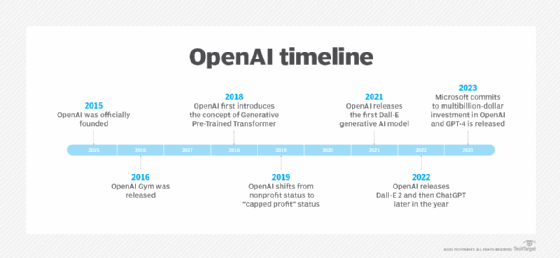What is OpenAI?
OpenAI is a private research laboratory that aims to develop and direct artificial intelligence (AI) in ways that benefit humanity as a whole. The company was founded by Elon Musk, Sam Altman and others in 2015 and is headquartered in San Francisco.
OpenAI was created in part because of its founders' existential concerns about the potential for catastrophe resulting from carelessness and misuse of general-purpose AI. The company has a long-term focus on fundamental advances in AI and its capabilities. The founders of the company and other investors started the company with a $1 billion endowment. In February 2018, Elon Musk left the company due to a potential conflict of interest with his work at Tesla, the automotive and clean energy company inspired by Nikola Tesla.
The stated intent of the company -- to work toward safe artificial general intelligence (AGI) for the benefit of humanity -- is reflected in its objective to freely collaborate with other research organizations and individuals. Research and patents made by the company are intended to remain open to the public except in cases where they could negatively affect safety.
Timeline and history of OpenAI
OpenAI was originally focused on developing AI and machine learning tools for video games and other recreational purposes. Less than a year after its official founding on Dec. 11, 2015, it released its first AI offering: an open source toolkit for developing reinforcement learning (RI) algorithms called OpenAI Gym. Over the next two years, OpenAI focused on more general AI development and AI research.
This article is part of
What is GenAI? Generative AI explained
In 2018, OpenAI published a report to explain to the world what a Generative Pre-trained Transformer (GPT) is. A GPT is a neural network, or a machine learning model, created to function like a human brain and trained on input, such as large data sets, to produce outputs -- i.e., answers to users' questions.
In March 2019, OpenAI shifted from nonprofit to capped-profit status and became formally known as OpenAI LP, controlled by parent company OpenAI Inc. Almost two years later, in January 2021, OpenAI introduced Dall-E, a generative AI model that analyzes natural language text from human users and then generates images based on what is described in the text.
Perhaps the company's best-known product is ChatGPT, released in November 2022 and heralded as the world's most advanced chatbot for its ability to provide answers to users on a seemingly unlimited range of topics. Its benefits and drawbacks, as well as its uses in various industries, are still being debated.
Elon Musk no longer serves on the board of the company, and co-founder Sam Altman served as the company's CEO until November 2023 alongside president and chairman Greg Brockman, formerly the CTO of financial services and SaaS company Stripe; and chief scientist Ilya Sutskever, formerly of Google.
In November 2023, Altman was fired from his position by the board of directors, citing that Altman was not candid in his communications to the board. Soon after, Brockman left the company. Both were hired by Microsoft three days after leaving the company.
Emmet Shear, co-founder of Twitch, was hired as the interim CEO at OpenAI after Altman's departure. Following Altman's firing, approximately 500 of OpenAI’s employees said they would quit if the board of directors didn't step down. After just five days, Altman and Brockman were re-hired in their original roles at OpenAI with a new board of directors.
In June 2025, Barbie maker Mattel announced a partnership with OpenAI to develop AI-powered toys and games. According to a statement from Mattel, the collaboration will use AI to create innovative play experiences. Mattel also announced a move to incorporate ChatGPT into its business operations to "enhance product development and creative ideation, drive innovation and deepen engagement with its audience."
In June 2025, OpenAI received a $200 million contract to work with the Defense Department. OpenAI will provide the Defense Department with AI tools and models. In a blog post, OpenAI announced an initiative, OpenAI for government, providing AI technology for U.S. public servants. The collaboration with the Department of Defense is the pilot program of the initiative, and will use OpenAI technology to streamline administrative operations, improve healthcare for service members and support cyber defense. In a statement from the U.S. Department of Defense, it is said that OpenAI will help address critical national security challenges in both warfighting and enterprise domains.

Notable projects and releases
OpenAI has been deemed revolutionary for its notable product offerings, which include the following:
- GPT-3. This powerful large language model (LLM) serves as the basis for other OpenAI products. It analyzes human-generated text to learn to generate similar text on its own.
- GPT-4. Released in March 2023, GPT-4 delivers multimodal AI functionality, where it can analyze both text and images.
- GPT-4.1. Released in April 2025, GPT-4.1 is a family of developer feedback trained LLMs, built on the architecture of previous GPT-4 era models, but with improvements to reliability and information processing. The model has been optimized to improve instruction following and front-end coding capabilities.
- GPT-4o. Introduced in May 2024, GPT-4o enhanced multimodal capability to recognize images, text and audio. GPT-4o is more conversational than other models. GPT-4o will recognize the user’s screens and photos and ask questions about them.
- GPT-4.5. Released in February 2025, GPT-4.5 is a general-purpose LLM that aims to provide more natural human-like interactions.
- OpenAI o1. Released in September 2024, OpenAI o1 is an LLM with enhanced reasoning functionality. Instead of providing a response as quickly as possible, o1 "thinks" through the right approach to solve a problem for more accurate responses.
- OpenAI o3. Released in April 2025, OpenAI states this model is the company's most powerful reasoning model, and the second release from the OpenAI reasoning model branch. The model is specifically designed to excel at tasks requiring deep analytical thinking and is especially strong at visual tasks such as analyzing images, charts, and graphics.
- Open AI o3-pro. In June 2025, OpenAI announced o3-pro, a model with the highest level of performance in the o-series at the time of release. The model is said to think longer and provide extremely reliable responses. As it takes more time to reason, it is slower than other o3 models. The o3-pro model has capabilities in web search, file analysis and Python.
- OpenAI o4-mini. Released in April 2025, OpenAI o4-mini is one of the company's smaller models designed with fast, effective reasoning. Its efficiency means that it has higher usage levels than its predecessor.
- ChatGPT Search. This AI search engine is currently built into ChatGPT for Plus and Team users. The search feature provides up-to-date information from the internet and allows ChatGPT to compete with other search engines. It was released in October 2024.
- Dall-E and Dall-E 2. These generative AI platforms can analyze text-based descriptions of images that users want them to produce and then generate those images exactly as described.
- Clip. Clip is a neural network that synthesizes visuals and the text pertaining to them to predict the best possible captions that most accurately describe those visuals. Because of its ability to learn from more than one type of data -- both images and text -- it can be categorized as multimodal AI.
- ChatGPT. ChatGPT is currently the most advanced AI chatbot designed for generating humanlike text and producing answers to users' questions. Having been trained on large data sets, it can generate answers and responses the way a human would. Since its creation, updates to this tool have allowed it to communicate with users through voice conversation and images.
- Codex. Codex was trained on billions of lines of code in various programming languages to help software developers simplify coding processes. It's founded on GPT-3 technology, but instead of generating text, it generates code.
- Whisper. Whisper is labeled as an automatic speech recognition (ASR) tool. It has been trained on a multitude of audio data in order to recognize, transcribe and translate speech in about 100 different languages, including technical language and different accents.
- ChatGPT Enterprise. Although this is similar to the consumer version of ChatGPT, the enterprise version lets users construct the training of their model. This edition also reflects on the recent incremental changes made to ChatGPT.
- Custom GPTs. GPTs are custom versions of ChatGPT that users can tailor to specific use cases without any code. Verified GPT builders can share custom GPTs in the GPT store and earn money doing so.
OpenAI and Microsoft
At the start of 2023, Microsoft publicly committed to a multibillion-dollar investment in OpenAI, but its interest in the company is nothing new. In July 2019, OpenAI engaged in a multiyear partnership with Microsoft in which Microsoft's cloud platform, Azure, has been enhanced by AI-based computing products.
Microsoft's latest investment in OpenAI extends to Bing, its search engine. The company is using the same technology developed for ChatGPT to produce an AI-infused version of Bing. Concurrently, AI-based features have also been added to Microsoft's Edge browser, and ChatGPT functionality is being added to Microsoft 365 products such as Outlook and Teams.
Criticisms of OpenAI
Despite all these rapid advancements, OpenAI has not been immune to criticism, both in the world of tech and beyond. The company's shift from "nonprofit" to "capped profit" status in 2019 fueled criticism that its commitment to working with others on building "safe and beneficial" general artificial intelligence had become a profit-driven "AI arms race" to produce the most advanced AI technology on the market. Simultaneously, others have expressed concerns about OpenAI's growing lack of transparency into how its groundbreaking products are being developed, given its commitment to developing open source software.
More recently, the debut of ChatGPT in late 2022 has come into a fair deal of criticism alongside the widespread praise for its groundbreaking abilities. The technology has been accused of producing "hallucinations" or other factually inaccurate answers that are ostensibly intelligent and well written, yet don't hold up under scrutiny. While this is perhaps the most infamous drawback of the platform, others include its potential to plagiarize from other sources as well as its limitations in producing answers on the most up-to-date news. The data set it was trained on was from 2021, so the content it generates could disservice those who require information on current events. OpenAI updated ChatGPT Plus in November 2023 to include information up to April of that year.
OpenAI’s chatbots are among many that faced safety concerns early in 2023. Aside from the assistive capabilities of these resources, researchers also detected toxic content in their responses. Examples of these include information on how to construct a bomb, along with guidance on how to perform identity theft and steal from a charity.
International skepticism surrounding AI also continues to emerge. The French and Italian governments, for example, provided demands and assessments for OpenAI. Meanwhile, the U.S. White House requested further information related to the risks associated with AI.
Lawsuits surrounding copyright with OpenAI have also come up. In June, creators faced scrutiny amid a charge from Joseph Saveri Law Firm. Made on behalf of five book authors, this accusation indicated ChatGPT and its underlying LLMs -- GPT-3.5 and GPT 4 -- contained copyrighted materials. Specifically, it accused these sources of using the authors' copyrighted works for summaries to train the LLMs. This took place without permission from the authors.
The New York Times also sued OpenAI and Microsoft in December 2023 for copyright infringement, accusing them of illegally copying articles to train LLMs and create AI products that compete with The New York Times. The paper was the first major news organization to sue OpenAI and Microsoft for using their publications to train AI systems.
Among concerns, actions to improve the system often take place. In response to the skepticism surrounding ChatGPT, OpenAI introduced ChatGPT Enterprise in August. With this new version, organizations can have a better hold on model training and the data that exists within models. However, there remains a lack of clarity surrounding the training data used by the model. As such, enterprises have shared concerns about the model using copyrighted material for training.
OpenAI has also faced criticism surrounding lack of diversity on its board of directors. Critics noted the board’s lack of representation isn't in line with the company’s mission to “benefit all of humanity.” Following the firing and rehiring of Sam Altman in November 2023, OpenAI ousted its only two female board members and reinstated a board made up exclusively white men. Lawmakers in Washington also recommended that OpenAI diversify its board following the restructuring.
The future of OpenAI
OpenAI has not provided extensive public commentary on future plans, but based on recent investments, democratization of AI is a clear goal of the Microsoft-OpenAI partnership, as nontechnical professionals should soon have more AI tools at their disposal that do not require AI expertise.
Microsoft has also taken actions that seem to indicate the expected growth of OpenAI and similar resources. In 2023, the company announced an investment of more than $13 billion in OpenAI. With the goal of sustaining the use of AI for various purposes, the investment gained a large amount of support following its comparison to the internet revolution.
In the 1990s, Bill Gates released a memo that described the internet as a "tidal wave" that would have a large impact on Microsoft. While referencing this memo, Microsoft CEO Satya Nadella recently noted the similarities between internet and AI growth. Furthermore, Microsoft is aiming to use these tools to support innovation.
In parallel with its anticipated growth, OpenAI hosted its first ever developer conference in November 2023. At the event, OpenAI unveiled GPT-4 Turbo, a language model with a significantly larger context window than its predecessors, a cheaper API pricing model and a later training data cut. OpenAI also debuted customizable GPTs, a “Copyright Shield” that will protect customers from legal action, and GPT store where users can monetize and access custom GPTs.
In December 2023, OpenAI struck a deal with media company Axel Springer to use its news content in OpenAI’s products. This lets ChatGPT give news summaries from Axel Springer’s outlets, which include Politico and Business Insider. The deal shows OpenAI’s intent to explore opportunities in AI-powered journalism.
Currently, OpenAI is in early talks with the California attorney general's office to change is corporate structure from a capped-profit business to a for-profit business. OpenAI started as a nonprofit AI research lab in 2015.







